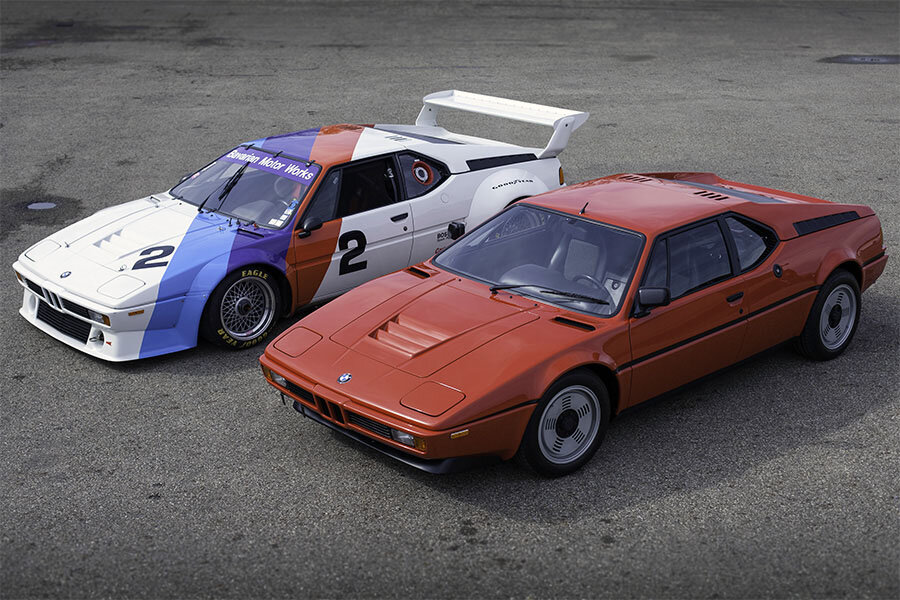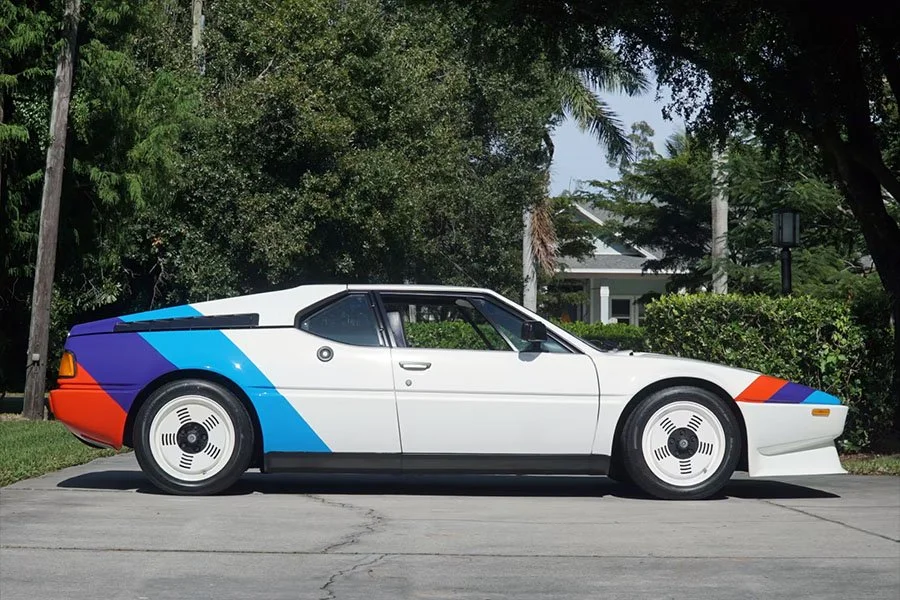Guide: BMW E26 M1 - a Historical & Technical Appraisal
/BACKGROUND
BMW’s high profile motor sport programme of the 1970s spawned some spectacular machinery and greatly enhanced the Munich firm’s reputation. However, Porsche remained the dominant force in GT racing and Germany’s premier high performance car manufacturer.
In an attempt to win the highly prized Group 5 World Championship for Manufacturers, BMW Motorsport boss, Jochen Neerpasch, devised a new mid-engined flagship for the 1978 season.
The M1 saga began in mid 1975, shortly before the FIA’s highly anticipated Group 5 regulations came into effect.
Sometimes referred to as a Silhouette formula, Group 5 was for radically modified Special Production Cars that retained little more than the original engine block, engine position, bonnet, roof and door profile of the base model.
To qualify for Group 5, a manufacturer first had to homologate the base model into Group 1, 2, 3 or 4.
BMW planned to homologate the M1 into Group 4 which required a production run of 400 identical units over a 24 month period.
The project was approved by BMW management in 1976 on the condition it would not interfere with the production of any other models.
As BMW Motorsport did not have the capacity to design, develop and produce the M1, Neerpasch sought a specialist manufacturer to partner with.
Cash-strapped Lamborghini was selected.
To secure the contract and safeguard jobs at Lamborghini, the near bankrupt firm received investment of over £1m from the Italian government. However, much of this money was squandered on the absurd Cheetah military all-terrain vehicle.
By the time M1 production was scheduled to begin, just seven prototypes were running and considerable work was still required.
A dismayed BMW pulled the plug in April 1978.
Fortunately, a group of former Lamborghini employees established Italengineering less than ten miles from Sant’Agata and completed the work.
BMW were still left to organise a complicated assembly procedure.
Chassis for the M1 were fabricated by Marchesi. The bodywork was created by fibreglass specialist, Trasformazione Italiana Resina. Both firms were based in Modena.
Partial assembly then took place at Ital Design in Turin from where the cars were sent to the Baur coachworks in Stuttgart. At this point, engines and interiors were installed.
Completion and final inspection occurred at the BMW Motorsport factory in Munich.
CHASSIS
The M1’s square section steel-tube spaceframe and MacPherson strut suspension were designed by ex-Lamborghini chassis guru, Giampaolo Dallara.
Unequal length wishbones, coil springs and adjustable gas-filled Bilstein dampers were fitted to each corner. Anti-roll bars were installed at either end.
Importantly, the geometry was suitable for Pirelli’s new ultra low profile P7 tyres. The P7s wrapped distinctive radial-straked 16-inch Campagnolo alloy wheels that measured 7-inches wide at the front and 8-inches wide at the back.
A space saver tyre was housed in the luggage compartment behind the engine.
Brakes were servo-assisted ventilated discs that ran off a hydraulic circuit for each axle. Brake disc diameter was 300mm front and 297mm rear.
Two 58-litre fuel tanks were installed on both sides ahead of the rear axle. Each was served by a separate filler.
ENGINE / TRANSMISSION
The M1’s straight six dual overhead camshaft engine featured a cast iron block and light alloy head. It was derived from the 3.5-litre M30 unit used in contemporary 6 and 7 series models. This engine had in turn been developed from the three-litre M30 motor used in the E9 CSL.
Displacement was the familiar 3453cc thanks to bore and stroke of 93.4mm and 84mm respectively.
Compared to the standard 3.5-litre production ‘six’, the M1’s Type M88 unit featured a host of significant upgrades.
It was equipped with new pistons, longer connecting rods, a forged steel seven bearing crankshaft and Kugelfischer mechanical fuel-injection.
A four-valve cylinder head was installed (as seen on CSL racing engines) along with individual 46mm throttle bodies for each cylinder.
The engine was dry-sumped and further uprated with Magnetti Marelli electronic ignition.
Running a compression ratio of 9.0:1, the Type M88 engine produced 277bhp at 6500rpm and 239lb-ft at 5000rpm.
Transmission was via five-speed ZF DS25 gearbox, a Fichtel & Sachs hydraulic twin-plate clutch and limited-slip differential.
BODYWORK
Visually, the M1 was inspired by the Paul Bracq-designed E25 Turbo concept unveiled at the Paris Motor Show in 1972.
Unlike so many supercars of the era, the M1 was unadorned by the kind of wings, scoops and blisters that were commonly found.
The body was penned by Giorgetto Giugiaro at his Ital Design studio and fabricated from glass-reinforced plastic. Body panels were bonded to the chassis at the Ital Design headquarters in Turin.
Although it retained some traditional BMW styling cues (most notably nose-mounted kidney grilles), the M1 was a complete departure from any of the marque’s previous production models.
Retractable headlights were used for the first time while a matt black chin spoiler was the M1′s only obvious aerodynamic aid.
Matt black Miura-style slats spanned the rear buttresses and matching engine vents were located along the sail panels.
The tail fascia comprised a pair of 6-series light clusters split by a central panel that was also finished in matt black.
INTERIOR
Ergonomically, the M1 was unmatched.
Designed with typical Germanic attention to detail, the cockpit provided good visibility with an unimpeded view of the instrumentation and switchgear (much of which was sourced from BMW’s production models).
Black leather was used to upholster the dash, upper and lower door panels, the central console and transmission tunnel. The same hide was also used for the Recaro seat bolsters.
Seat and door centres were trimmed in grey fabric. The carpet was also grey.
Standard equipment included air-conditioning, electric windows, electric mirrors, a three-spoke leather-rimmed BMW Motorsport steering wheel, heated rear window and Becker radio / cassette player.
OPTIONS
Options were limited to fitted luggage, lowered seats and mud flaps. A few cars were also retro-fitted with Group 4 body kits.
WEIGHT / PERFORMANCE
Kerb weight was 1300kg.
BMW quoted a top speed of 163mph and 0-62mph time of 5.5 seconds.
LAUNCH
The prototype M1 was presented to members of the press at Munich’s Olympic Stadium in July 1978.
It was displayed alongside a BMW Motorsport-liveried Group 4 version, but production delays meant the original homologation plan had long since gone out of the window.
However, Jochen Neerpasch had secured something of a coup; Group 4 M1s would be able to compete in a one-make ‘Procar’ championship that supported several European Formula 1 races in 1979 and 1980.
PRODUCTION
The first dozen pre-production test and show cars were completed between September and December of 1978.
The M1’s public launch came at the Paris Motor Show in October 1978.
Deliveries started in January 1979, but the car’s high price proved to be a big problem and large discounts were often needed to get them out of dealer showrooms.
Production ended in July 1981, by which time 399 road cars had been completed.
Group 4 homologation was eventually approved on April 1st 1981, three years later than originally planned.
Text copyright: Supercar Nostalgia
Photo copyright: BMW - https://www.bmw.com



































